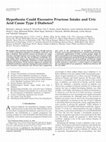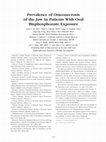Papers by Gabriela Sanchez

Endocrine Reviews, 2008
We propose that excessive fructose intake (>50 g/d) may be one of the underlying etiologies of me... more We propose that excessive fructose intake (>50 g/d) may be one of the underlying etiologies of metabolic syndrome and type 2 diabetes. The primary sources of fructose are sugar (sucrose) and high fructose corn syrup. First, fructose intake correlates closely with the rate of diabetes worldwide. Second, unlike other sugars, the ingestion of excessive fructose induces features of metabolic syndrome in both laboratory animals and humans. Third, fructose appears to mediate the metabolic syndrome in part by raising uric acid, and there are now extensive experimental and clinical data supporting uric acid in the pathogenesis of metabolic syndrome. Fourth, environmental and genetic considerations provide a potential explanation of why certain groups might be more susceptible to developing diabetes. Finally, we discuss the counterarguments associated with the hypothesis and a potential explanation for these findings. If diabetes might result from excessive intake of fructose, then simple public health measures could have a major impact on improving the overall health of our populace. (Endocrine Reviews 30: 96 -116, 2009)

Journal of Oral and Maxillofacial Surgery, 2010
Purpose: Osteonecrosis of the jaw (ONJ) is a serious complication associated with bisphosphonate ... more Purpose: Osteonecrosis of the jaw (ONJ) is a serious complication associated with bisphosphonate therapy, but its epidemiology in the setting of oral bisphosphonate therapy is poorly understood. The present study examined the prevalence of ONJ in patients receiving chronic oral bisphosphonate therapy. Materials and Methods: We mailed a survey to 13,946 members who had received chronic oral bisphosphonate therapy as of 2006 within a large integrated health care delivery system in Northern California. Respondents who reported ONJ, exposed bone or gingival sores, moderate periodontal disease, persistent symptoms, or complications after dental procedures were invited for examination or to have their dental records reviewed. ONJ was defined as exposed bone (of Ͼ8 weeks' duration) in the maxillofacial region in the absence of previous radiotherapy. Results: Of the 8,572 survey respondents (71 Ϯ 9 years, 93% women), 2,159 (25%) reported pertinent dental symptoms. Of these 2,159 patients, 1,005 were examined and an additional 536 provided dental records. Nine ONJ cases were identified, representing a prevalence of 0.10% (95% confidence interval 0.05% to 0.20%) among the survey respondents. Of the 9 cases, 5 had occurred spontaneously (3 in palatal tori) and 4 occurred in previous extraction sites. An additional 3 patients had mandibular osteomyelitis (2 after extraction and 1 with implant failure) but without exposed bone. Finally, 7 other patients had bone exposure that did not fulfill the criteria for ONJ. Conclusions: ONJ occurred in 1 of 952 survey respondents with oral bisphosphonate exposure (minimum prevalence of 1 in 1,537 of the entire mailed cohort). A similar number had select features concerning for ONJ that did not meet the criteria. The results of the present study provide important data on the spectrum of jaw complications among patients with oral bisphosphonate exposure.
Uploads
Papers by Gabriela Sanchez